Have you ever seen a fish with really big lips? It might sound silly at first, but they’re completely real! These puffy lips help some fish stand out in the water. You can find them in oceans, rivers, and lakes around the world.
But why do they have such large lips? Their lips aren’t just for looks; they actually help them survive. These fish with big lips use them to grab food from rocks, hide from predators, or sometimes even to impress a mate. Cool, right?
In this article, we’re going to explore different types of fish with big lips, why they look this way, and how these special lips help them live in the wild. So, keep reading and get ready to discover some of the most unique and interesting fish in the water!
List of 30 Fish With Big Lips
Did you know some fish have lips so big they look like they’re wearing lipstick? It might sound funny, but these unique fish live in oceans, rivers, and even home aquariums. Their thick lips don’t just make them stand out; they help them eat, survive, and impress other fish.
Here’s a fun and easy to read list of 30 fish species with big lips:
| No. | Fish Name | What Makes It Special |
| 1. | Humphead Wrasse | A huge, colorful reef fish with thick, rubbery lips. |
| 2. | Sweetlips Fish | Named for its soft, pouty lips; found near coral reefs. |
| 3. | Napoleon Fish | A giant reef fish with big lips and a bump on its head. |
| 4. | Triggerfish | Some types have big lips to help crush hard-shelled prey. |
| 5. | Largemouth Bass | A freshwater fish with a wide mouth and fleshy lips. |
| 6. | Sheepshead Fish | Known for human-like teeth and chunky lips. |
| 7. | Flowerhorn Cichlid | Aquarium fish with pouty lips and a large forehead bump. |
| 8. | Oscar Fish | Popular pet fish with expressive, thick lips. |
| 9. | Parrotfish | Has beak-shaped lips for scraping algae off coral. |
| 10. | Gourami Fish | Freshwater fish with thick lips, often seen in tanks. |
| 11. | Red Snapper | Deep-sea fish with plump lips and sharp teeth. |
| 12. | Grouper Fish | Big-mouthed hunter with strong, fleshy lips. |
| 13. | Clown Triggerfish | Bright colors and curved, thick lips. |
| 14. | Pacu Fish | Has human-like teeth and thick lips for crunching nuts. |
| 15. | Catfish | Some have large, fleshy lips and long whiskers. |
| 16. | Koi Fish | Pond fish with soft lips used for sucking up food. |
| 17. | Mudskipper | Can walk on land and has thick lips for feeding. |
| 18. | Jack Dempsey Fish | A tough fish with noticeable lips and bold colors. |
| 19. | Peacock Bass | Large freshwater predator with thick lips. |
| 20. | Pufferfish | Inflates like a balloon and has soft, pouty lips. |
| 21. | Tarpon Fish | Large silver fish with big, rubbery lips. |
| 22. | Elephant Nose Fish | Has a long snout and thick lips for finding food. |
| 23. | Tilapia | Common fish with fleshy lips used to grab food. |
| 24. | Moray Eel | Long body, sharp teeth, and plump lips. |
| 25. | Barramundi | Freshwater fish with a big mouth and thick lips. |
| 26. | Bichir Fish | Ancient-looking fish with big lips and lung-like organs. |
| 27. | Dragonet Fish | Small, colorful fish with soft, fleshy lips. |
| 28. | Snakehead Fish | Fierce predator with thick lips and sharp teeth. |
| 29. | Rockfish | Deep-sea fish with puffy lips and large eyes. |
| 30. | Suckermouth Catfish | Uses its big lips to stick to rocks and eat algae. |
Top 20 Fish With Big Lips Full Details
Fish with big lips might look funny at first, but they are some of the most fascinating creatures in the water. You can find these big lipped fish in oceans, rivers, and even lakes all around the world. Their large, fleshy lips aren’t just for show; they help them catch food, protect themselves from predators, and sometimes even attract a mate.
Some fish with thick lips use them to crush hard shells like crabs or snails. Others use their lips to feel around in dark or muddy water to find food. These special lips act like tools, helping the fish survive in their environment.
In this guide, you’ll explore 20 amazing fish with big lips, along with their scientific names, diets, sizes, and what makes each one special. From colorful reef fish to strong river hunters, every fish on this list has something unique that makes it stand out.
1. Humphead Wrasse
Scientific Name: Cheilinus undulatus
Diet: Small fish, crabs, sea urchins, and shellfish
Size: Grows up to 7 feet (2.1 meters)
The Humphead Wrasse, also known as the Napoleon Wrasse, is one of the largest and most eye catching reef fish with big lips. This gentle giant can grow up to 7 feet long, which is taller than most people! Its thick, fleshy lips help it crush tough foods like crabs, sea urchins, and shellfish with ease.
Although this fish appears strong and bold, with its large forehead and pouty lips, it plays a crucial role in maintaining the health of coral reefs. By eating harmful creatures like crown of thorns starfish, the Humphead Wrasse helps protect coral reefs from damage.

Details:
The Humphead Wrasse, also called the Napoleon Wrasse, is one of the biggest and most colorful coral reef fish in the world. This giant fish has thick, fleshy lips that it uses to crush hard shelled animals like sea urchins, crabs, and shellfish. You can find it swimming in warm coral reefs across the Indian and Pacific Oceans.
This fish can grow over 7 feet long and live for more than 30 years, which is pretty amazing! But here’s something even more surprising: some female Humphead Wrasses can change into males as they get older. This is known as gender change or sex reversal, and it helps the species survive.
The Humphead Wrasse is very important for the ocean. It eats crown of thorns starfish, a dangerous animal that can destroy coral reefs if it spreads too much. By controlling these starfish, the wrasse helps keep coral reefs healthy and alive.
Related Article: Are Blue Axolotls Real? The Truth Revealed!
2. Sweetlips Fish
Scientific Name: Plectorhinchus (various species)
Diet: Small fish, shrimp, and worms
Size: 12 to 36 inches (30 to 90 cm)
The Sweetlips Fish gets its name from its big, soft, and pouty lips, which make it look like it’s always making a funny face. These colorful reef fish with big lips are usually found swimming around coral reefs in the warm waters of the Indian and Pacific Oceans.
Sweetlips Fish come in many patterns; some have bright stripes, while others have dots or bold colors that change as they grow. Their large, fleshy lips help them suck up food like shrimp, worms, and tiny fish hiding in rocks and sand.
Even though they look calm and gentle, young Sweetlips move their bodies in a wiggly way to confuse predators and keep themselves safe. As they grow older, they swim more slowly and gracefully.
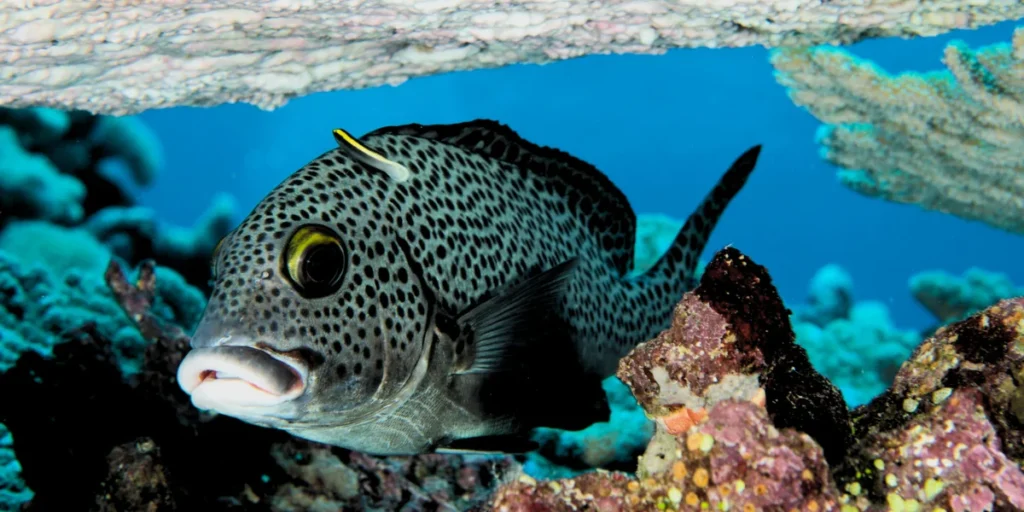
Details:
Sweetlips Fish are easy to recognize thanks to their thick, soft lips and eye catching colors. These beautiful reef fish with big lips live in warm coastal waters near coral reefs, mainly in the Indian and Pacific Oceans.
When they are young, Sweetlips Fish swim in a wiggly, wave like way that makes them look like floating seaweed. This clever trick helps them stay safe from bigger fish. As they grow older, their colors and patterns change, and they start swimming in groups for protection and food.
Their large, fleshy lips aren’t just for looks. Sweetlips use them to suck tiny fish, worms, and shrimp out of sand and rocky cracks. Because of their bright stripes and unique appearance, they are popular in large public aquariums around the world.
3. Napoleon Fish
Scientific Name: Cheilinus undulatus
Diet: Crustaceans, mollusks, and starfish
Size: Up to 7 feet (2.1 meters)
The Humphead Wrasse, also known as the Napoleon Wrasse, is a giant reef fish with thick, pouty lips and bright colors that make it stand out in the ocean. This incredible fish can grow up to 7 feet long, almost as tall as a door!

Details:
The Napoleon Fish, also known as the Humphead Wrasse, is one of the biggest and most unforgettable coral reef fish in the world. You can easily spot it by its large, bumpy forehead and big, fleshy lips that make it look both funny and fascinating at the same time. This giant can weigh up to 400 pounds (180 kg) and grow over 6 feet long!
Even though it’s a slow swimmer, the Napoleon Fish is incredibly strong. Its powerful jaws and thick lips help it crush hard shelled animals like crabs, sea urchins, and mollusks. You’ll often find it swimming around coral reefs in the Indian and Pacific Oceans, searching for tasty sea cucumbers and other reef creatures.
4. Triggerfish
Scientific Name: Balistidae (various species)
Diet: Sea urchins, shellfish, and algae
Size: 8 to 35 inches (20 to 90 cm)

Details:
Triggerfish are fascinating reef creatures with big, tough lips and sharp, strong teeth that help them crush sea urchins, shellfish, and crabs with ease. Some species are so smart they even use rocks as tools, holding them in their mouths to crack open hard food, pretty clever, right?
But don’t be fooled by their bright colors. Triggerfish are known for being bold and aggressive, especially when protecting their nests. If you get too close, they’ll chase away fish much bigger than themselves and sometimes even divers! This strong protective behavior helps keep their eggs safe.
Their bodies are covered in thick, armor like scales that act like a shield against predators. These tough scales, along with their sharp teeth and quick thinking, make triggerfish powerful survivors in the ocean.
5. Largemouth Bass
Scientific Name: Micropterus salmoides
Diet: Small fish, insects, and frogs
Size: 12 to 30 inches (30 to 76 cm)
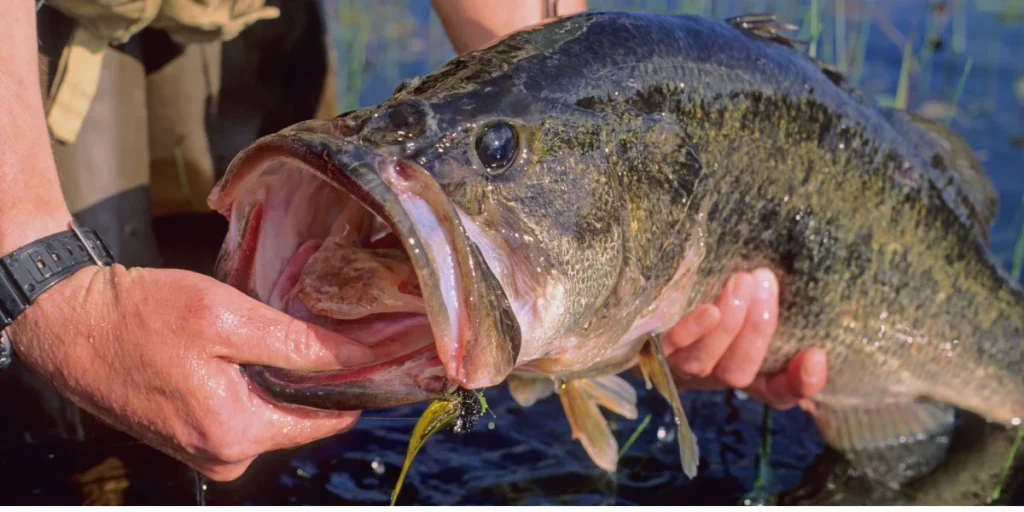
Details:
The Largemouth Bass is one of the most famous freshwater fish in North America. You can easily spot it in lakes, ponds, and slow moving rivers. It gets its name from its giant mouth, wide, thick lipped, and perfect for snapping up prey in a single gulp. This powerful predator will eat almost anything it can fit in its mouth, like smaller fish, frogs, insects, and sometimes even tiny birds!
What makes the largemouth bass even more exciting is how strong and wild it can be. When hooked, it jumps, twists, and fights with all its strength, which is why fishermen and sport anglers love it so much. That thrilling fight makes it one of the top fish for bass fishing and sport fishing across North America.
6. Sheepshead Fish
Scientific Name: Archosargus probatocephalus
Diet: Crabs, shrimp, and barnacles
Size: 10 to 30 inches (25 to 76 cm)
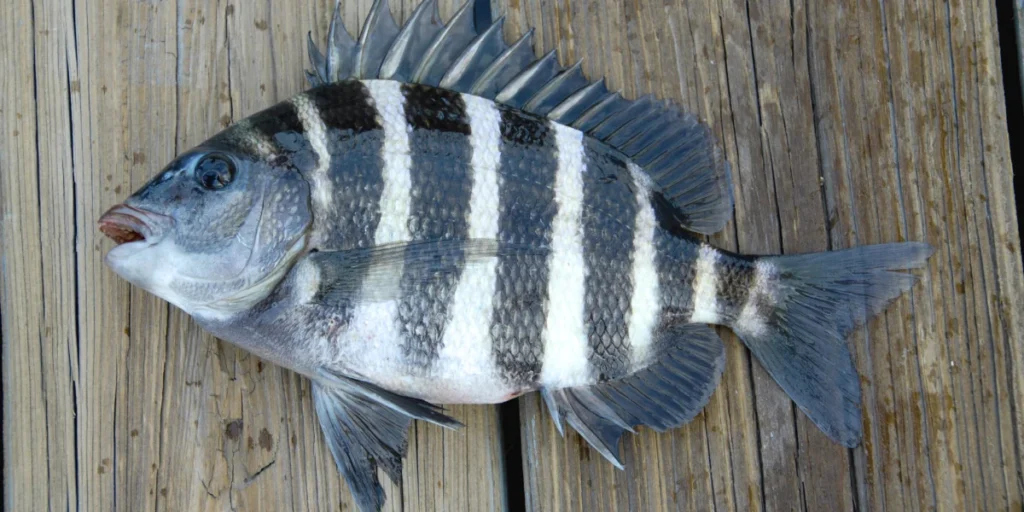
Details:
The Sheepshead Fish is one of the most unusual fish in the ocean, and you’ll see why the moment it opens its mouth. It has human like teeth, yes, real teeth that look like ours! These strong teeth and thick lips help it crush tough food like crabs, barnacles, and shellfish that other fish can’t even touch.
You can often spot this fish near piers, jetties, and rocky shores, especially in shallow coastal waters. It uses its powerful bite to scrape food off rocks, wooden pilings, and even old shipwrecks underwater. Because of the bold black and white stripes on its body, many people call it the “convict fish.”
Even though it looks a bit strange, the Sheepshead Fish plays an important role in the marine ecosystem and is a favorite catch for many saltwater anglers because of its challenge and tasty meat.
7. Flowerhorn Cichlid
Scientific Name: Hybrid species
Diet: Pellets, insects, and small fish
Size: 12 to 16 inches (30 to 40 cm)

Details:
The Flowerhorn Cichlid is one of the most eye catching aquarium fish in the world, and it’s not even found in the wild! This stunning fish is a man made hybrid species, famous for its big, bumpy head hump (nuchal hump) and thick, fleshy lips. Its bright colors and unique shape make it a favorite in many home fish tanks.
But don’t let its beauty fool you. Flowerhorns are aggressive and very territorial. They don’t like to share their space with other fish and may even attack tank mates. That’s why they’re usually kept alone in a separate aquarium setup.
In many cultures, especially across Asia, people believe the Flowerhorn fish brings good luck, wealth, and positive energy, which is why you’ll often see it in homes, offices, and shops.
8. Oscar Fish
Scientific Name: Astronotus ocellatus
Diet: Small fish, insects, and worms
Size: 12 to 18 inches (30 to 45 cm)

Details:
The Oscar Fish, also known as the Velvet Cichlid, is one of the smartest freshwater aquarium fish you can own. These fish are so intelligent that they can recognize their owners and even follow them around the tank! With their thick lips, strong jaws, and curious personalities, Oscars are full of surprises.
But don’t be fooled by their playful nature, Oscar fish grow quickly and need a large aquarium to swim comfortably. A small tank won’t work for them. They love rearranging tank decorations, rocks, and plants, almost like they’re designing their own room.
What makes them even more fascinating is their ability to change colors based on mood, stress, or excitement. When they’re happy, relaxed, or feeling threatened, their colors shift to show how they feel.
9. Parrotfish
Scientific Name: Scaridae (various species)
Diet: Algae and coral
Size: 12 to 47 inches (30 to 120 cm)
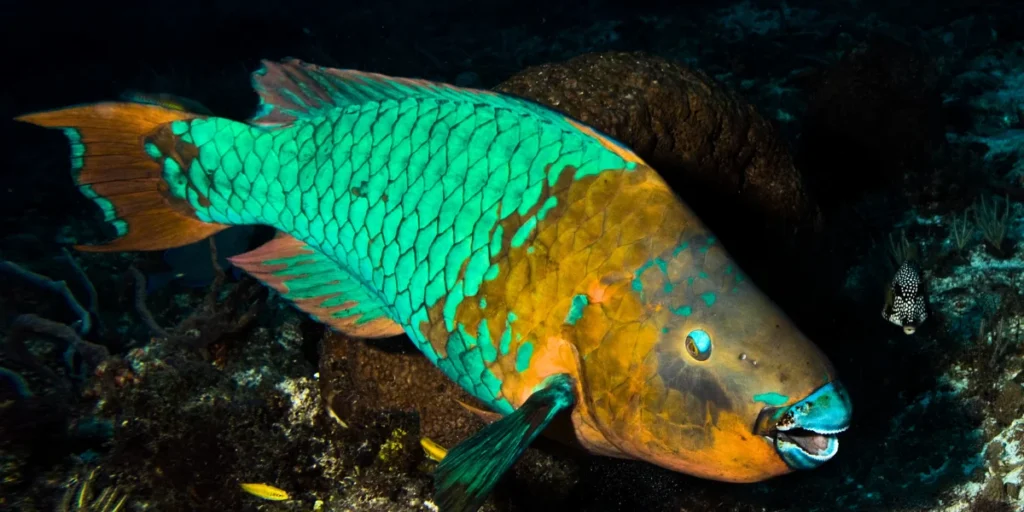
Details:
Parrotfish are one of the most colorful and unique fish on coral reefs. They have large, fleshy lips and teeth that are fused together, forming a strong beak like mouth. With this beak, they scrape algae off coral reefs, helping keep the reef clean and healthy. Without parrotfish, algae would grow too much and smother the coral.
But that’s not all, parrotfish have a super cool bedtime habit. At night, some species create a slimy mucus bubble, almost like a sleeping bag made of slime. This bubble hides their smell from predators like moray eels and keeps them safe while they sleep.
These amazing fish play a huge role in coral reef ecosystems, making them important for ocean health.
10. Gourami Fish
Scientific Name: Osphronemidae (various species)
Diet: Insects, plants, and small fish
Size: 2 to 28 inches (5 to 70 cm)

Details:
Gourami Fish are fascinating freshwater fish known for their thick, puffy lips and amazing way of breathing. Unlike many other fish, gouramis can breathe air directly from the surface thanks to a special organ called the labyrinth organ. This cool ability helps them survive in low oxygen water, like slow moving ponds or rice fields.
One of the most famous types is the Kissing Gourami. These fish gently press their lips together, almost like they’re kissing, but don’t be fooled! They’re not showing love. They’re actually fighting for territory or dominance in a peaceful looking way.
With their bright colors, calm behavior, and unique breathing, Gourami fish are popular aquarium pets and loved by fish keepers around the world.
11. Red Snapper
Scientific Name: Lutjanus campechanus
Diet: Small fish, shrimp, squid, and crabs
Size: 15 to 40 inches (38 to 100 cm)

Details:
The Red Snapper is a stunning deep sea fish famous for its bright red body and thick lips. With its strong jaws and sharp teeth, it easily catches smaller fish, shrimp, and other sea creatures. You can mostly find Red Snappers swimming in the Gulf of Mexico and along the Atlantic Coast of North America, especially near reefs and underwater structures.
People love this fish not just for its beauty, but also for its delicious and tender meat, making it a favorite on seafood menus. A Red Snapper can live for up to 50 years and grow more than 3 feet long, which is pretty impressive for a fish!
12. Grouper Fish
Scientific Name: Epinephelinae (various species)
Diet: Fish, crustaceans, and octopuses
Size: 12 to 98 inches (30 to 250 cm)
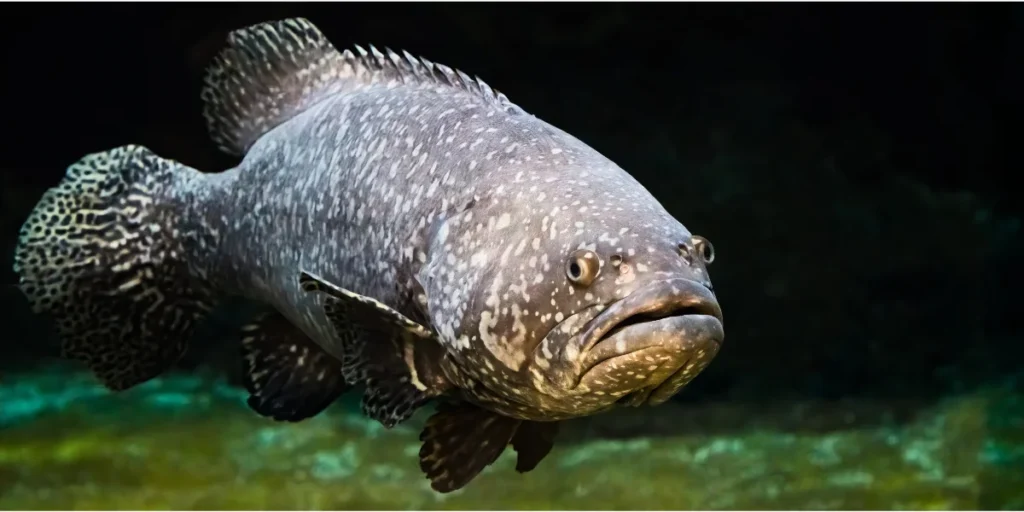
Details:
The Grouper Fish is known for its big body, thick lips, and giant mouth. Instead of chasing its food, this clever predator uses a powerful suction feeding technique. It opens its mouth fast and sucks in its prey in just a second! One of the most famous species, the Goliath Grouper, can grow over 800 pounds (360 kg) and is as long as a small car!
Groupers are usually slow swimmers. They like to stay hidden in rocky caves, coral reefs, and shipwrecks, waiting quietly for the perfect moment to attack. Even though they look calm, they play a huge role in protecting the ocean food chain by keeping smaller fish populations under control.
13. Clown Triggerfish
Scientific Name: Balistoides conspicillum
Diet: Sea urchins, crabs, and small fish
Size: 12 to 20 inches (30 to 50 cm)

Details:
The Clown Triggerfish is one of the most eye catching fish in the ocean. Its body is covered with bold black, white, yellow, and blue patterns that make it look like a living piece of art. Along with its bright colors, this fish has thick, curved lips and strong teeth, which it uses to crush tough prey like sea urchins, shellfish, and crabs.
But don’t let its beauty fool you, this fish has a fierce side. The Clown Triggerfish is known for being territorial and aggressive, especially during the breeding season. If another fish or even a diver comes too close to its space, it won’t hesitate to bite to protect its home.
14. Pacu Fish
Scientific Name: Colossoma macropomum
Diet: Fruits, nuts, and small fish
Size: 12 to 42 inches (30 to 107 cm)

Details:
The Pacu fish is one of the most fascinating freshwater fish you’ll ever hear about, mainly because it has teeth that look surprisingly human! These teeth, along with their thick lips and strong jaw, help the Pacu bite and grind hard foods like nuts, seeds, and even fruits that fall into the river. Although it is related to the fierce piranha, the Pacu is mostly peaceful and herbivorous, meaning it prefers plants over meat.
You’ll find Pacu fish in South American rivers, especially in the Amazon and Orinoco basins. However, some Pacu escape into lakes or rivers in other parts of the world, where they can become an invasive species and cause problems for local fish and ecosystems. Because of their unique appearance and calm nature, some people try to keep Pacu as aquarium pets, but this often becomes a big challenge. Why? Because they don’t stay small for long. A Pacu can grow up to 3 feet in length and weigh more than 50 pounds, so they need a huge tank or pond to live comfortably.
15. Catfish
Scientific Name: Siluriformes (various species)
Diet: Algae, fish, insects, and plant matter
Size: 4 to 52 inches (10 to 132 cm)

Details:
The catfish is one of the most unique freshwater fish you’ll ever come across. It has large, soft lips and long whisker like feelers called barbels. These barbels act like super sensitive fingers, helping the catfish find food in dark, muddy water where it can’t see clearly. Some types of catfish grow to unbelievable sizes, like the Mekong Giant Catfish, which can reach over 9 feet long and weigh more than a small car!
You can find catfish in freshwater and saltwater habitats all around the world. They’re known as bottom feeders, which means they search for food along the riverbed, lake floor, or even the ocean bottom. They eat things like insects, small fish, plants, and anything else they can find. But not all catfish are the same. Some species, like the electric catfish, can produce a shock of electricity to protect themselves from danger.
16. Koi Fish
Scientific Name: Cyprinus rubrofuscus
Diet: Algae, insects, and small plants
Size: 12 to 36 inches (30 to 90 cm)
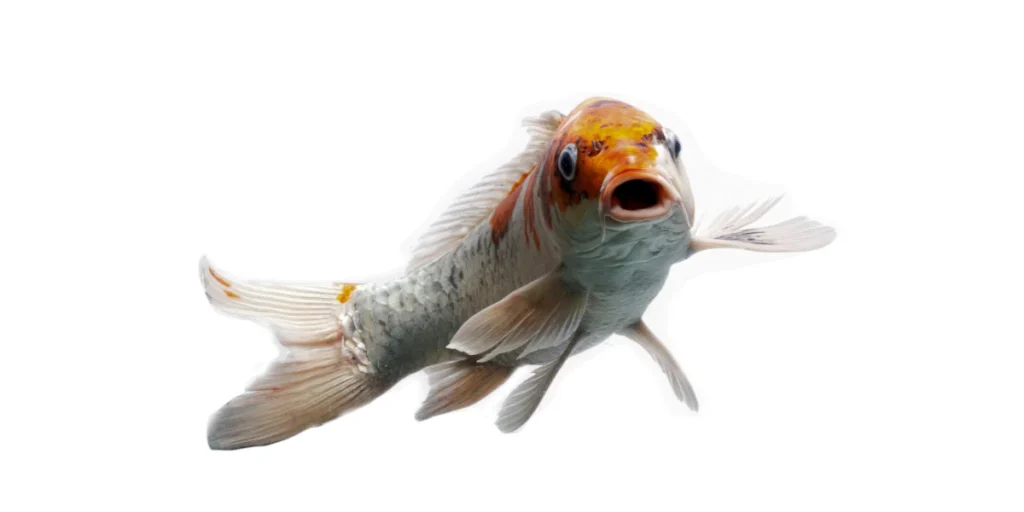
Details:
Koi fish are one of the most popular and beautiful freshwater pond fish in the world. Known for their bright colors and peaceful nature, these fish are often seen gracefully swimming in garden ponds and backyard water features. Their soft, fleshy lips help them suck up food from the bottom of the pond, making them excellent bottom feeders.
One of the most amazing things about koi fish is how long they can live. With proper care, clean water, and a healthy diet, many koi live over 30 to 50 years, and some have even reached more than 100 years old, which is longer than most people!
Koi come in stunning colors like orange, white, red, black, yellow, and blue, often with beautiful patterns across their bodies. Because of their beauty, koi fish are seen as symbols of luck, prosperity, strength, and good fortune, especially in Japanese and Chinese culture. In many gardens, they aren’t just pets, they’re living works of art.
17. Mudskipper
Scientific Name: Oxudercinae (various species)
Diet: Insects, small fish, and algae
Size: 3 to 12 inches (7 to 30 cm)

Details:
Mudskippers are truly one of the strangest and most fascinating fish in the world. Why? Because they can actually walk on land! Instead of staying in the water like most fish, mudskippers use their strong front fins to hop, crawl, and slide across wet mud. Their thick lips help them grab food like insects, worms, and small crabs right from the ground.
What makes them even more amazing is their ability to breathe air. Mudskippers can survive outside the water for hours by storing air in their gills and absorbing oxygen through their skin and mouth, kind of like a mix between a fish and an amphibian.
You’ll usually find mudskippers in muddy coastal areas, tidal flats, and mangrove forests in places like Asia, Africa, and Australia. To stay safe from predators and harsh sunlight, they dig burrows in the mud, which also helps them stay cool and moist.
18. Jack Dempsey Fish
Scientific Name: Rocio octofasciata
Diet: Insects, small fish, and worms
Size: 8 to 15 inches (20 to 38 cm)
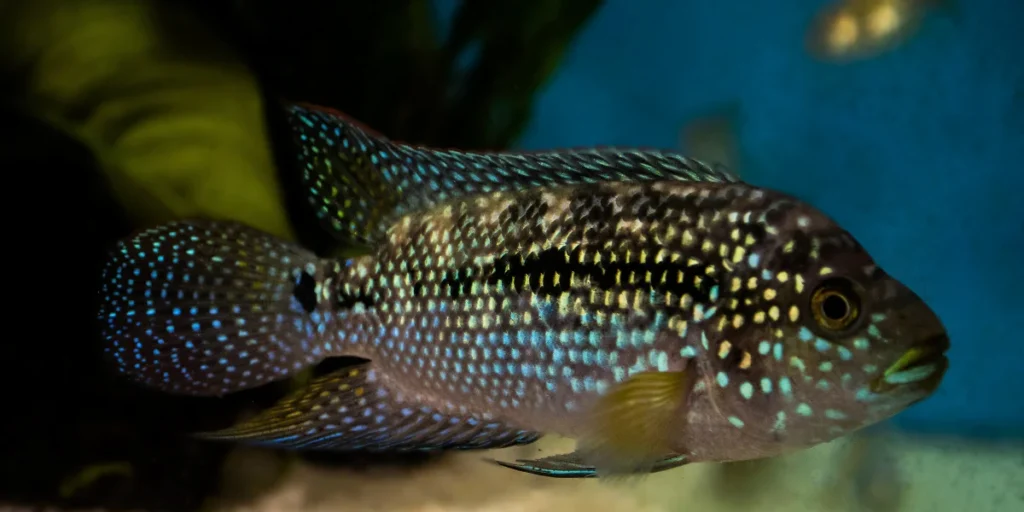
Details:
The Jack Dempsey Fish is a bold and tough freshwater fish known for its big lips, strong jaws, and fearless attitude. It gets its name from the famous boxer Jack Dempsey, and just like a real fighter, this fish doesn’t back down from a challenge. Jack Dempsey fish are highly territorial and will chase or even bite other fish that swim into their space.
Even though it has an aggressive nature, many people love keeping it in home aquariums because of its stunning blue, green, and gold shimmering scales. When the light hits its body, it glows like tiny underwater jewels. But don’t be fooled by its beauty; this fish needs a large tank, hiding spots, and should not be kept with smaller or peaceful fish, as it might hurt them.
19. Peacock Bass
Scientific Name: Cichla (various species)
Diet: Small fish, insects, and crustaceans
Size: 12 to 36 inches (30 to 90 cm)

Details:
The Peacock Bass is a powerful freshwater predator fish known for its thick lips, strong jaw, and lightning fast hunting skills. Originally found in the rivers and lakes of South America, this fish has now been introduced to other parts of the world for sport fishing because of its strength and exciting fight when hooked.
Peacock Bass are skilled hunters. They use their speed and powerful bite to catch smaller fish and other prey in just seconds. Their bodies are decorated with beautiful shades of yellow, green, and orange, making them one of the most eye catching fish in freshwater. Some species even have a black “eye spot” on their tail, which tricks predators into attacking the wrong end, giving them a better chance to escape.
Because of their bold colors, aggressive nature, and thrilling battles, anglers and fishing enthusiasts love this fish. However, they need large spaces, clean water, and plenty of prey to thrive in the wild or in large fishing ponds.
20. Pufferfish
Scientific Name: Tetraodontidae (various species)
Diet: Algae, shellfish, and small fish
Size: 3 to 24 inches (8 to 60 cm)
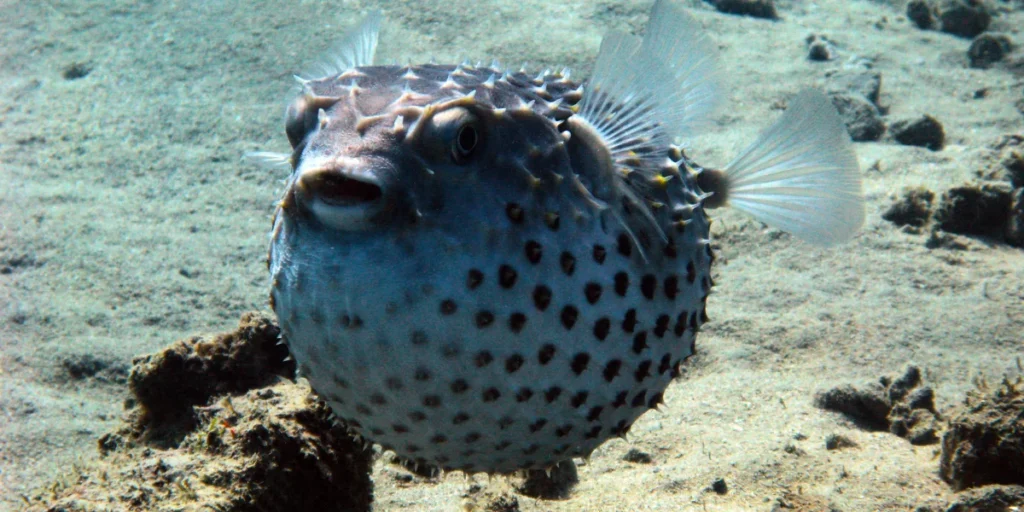
Details:
Pufferfish are well known for their soft, thick lips and their amazing defense trick they can puff up into a big, round ball when they feel scared. To do this, they quickly swallow water or air, making their bodies look several times bigger to frighten away predators.
But that’s not all. Some pufferfish species carry a powerful poison called tetrodotoxin. This toxin is so deadly that even a tiny amount can be dangerous to humans. Still, in Japan, a special pufferfish known as fugu fish is prepared and eaten as a rare and expensive seafood delicacy. Only trained and licensed chefs are allowed to make it because one small mistake can be fatal.
Even though their lips and faces may look funny or unusual, every pufferfish has a special role in the marine ecosystem. Some use their thick lips to crack open shells and hunt for food, while others rely on their ability to puff up for protection.
These fascinating fish remind us that nature is full of surprises sometimes; the smallest creatures have the most incredible superpowers.
Why Do Some Fish Have Big Lips?
Have you ever noticed that some fish have really big lips? They aren’t just for looks; these lips actually help them survive in the water in many clever ways. Let’s break it down:
1. Eating Tough Food
Fish like the Humphead Wrasse have big, strong lips that help them crush hard food, such as crabs, clams, and sea urchins. Their thick lips and powerful mouths let them eat things most other fish can’t.
2. Finding Food in Muddy Water
Catfish have big lips and special whiskers called barbels. These whiskers are super sensitive and help them feel and smell food in dark or muddy water where they can’t see well. It’s like having built in underwater sensors!
3. Staying Safe from Predators
The Pufferfish uses its thick lips and stretchy skin as part of its defense. When it feels scared, it sucks in water or air and puffs up like a balloon. This makes it look bigger and harder to bite.
4. Attracting a Mate
Fish like Koi not only use their soft lips to suck up food from the bottom of ponds, but these lips can also make them look more attractive to other fish. In the fish world, big lips can be a beauty feature!
So, Why Do Fish Have Big Lips?
Big lips help them eat, find food, stay safe, and even attract mates. From hunting to protecting themselves, those lips are more than just funny looking; they’re one of nature’s coolest survival tools.
FAQs
What is the Fish with Big Lips Called?
Some fish are famous for their big lips, which help them in various ways, such as feeding and defense. A prime example is the Humphead Wrasse, known for its thick, fleshy lips. Other fish, like the Sweetlips Fish and Clown Triggerfish, also have large, prominent lips that make them stand out in the underwater world.
What is the Name of the Fish with a Big Mouth?
Fish with big mouths are often effective hunters. The Grouper Fish, with its wide mouth, uses suction to catch prey like small fish and crustaceans. The Largemouth Bass, another example, is famous for its large, wide mouth, which it uses to catch a variety of prey, including smaller fish and insects.
What Kind of Fish Has a Large Mouth?
Fish like the Napoleon Fish (also known as the Humphead Wrasse) and the Largemouth Bass are well known for their large mouths. These fish have adapted to use their wide mouths to feed on larger prey or to break open hard shelled creatures. Their big mouths are essential for their feeding habits.
What Tropical Fish Has Thick Lips?
The Sweetlips Fish, found in tropical coral reefs, is one of the most notable tropical fish with thick lips. These soft, fleshy lips help the Sweetlips Fish feed on small prey and insects hidden in the reef. Its distinct look and colorful body make it a favorite among aquarium enthusiasts.
Conclusion
Have you ever seen a fish with big, puffy lips or a huge mouth and wondered why it looks like that? Well, it’s not just for show; these features help them survive in the wild.
Fish like the Humphead Wrasse, Sweetlips Fish, and Clown Triggerfish are famous for their thick, oversized lips. These big lips help them grab food, crush hard shells, and even sense tiny movements in the water. In busy coral reefs, Sweetlips Fish use their lips to search for worms, small crabs, and other hidden snacks.
Some fish, such as the Grouper and Largemouth Bass, don’t just have big lips; they also have large mouths. These wide mouths allow them to swallow prey in one quick gulp, including smaller fish and crustaceans. Groupers use a strong suction force to pull prey right into their mouths, while Largemouth Bass rely on speed and surprise to catch their meals.
In tropical oceans and coral reefs, big lips and large mouths are more than just strange features; they’re survival tools. These traits help fish with feeding, hunting, protection, and adapting to their environment.

1 thought on “Fish with Big Lips: Top 30 Types with Details & Photos”